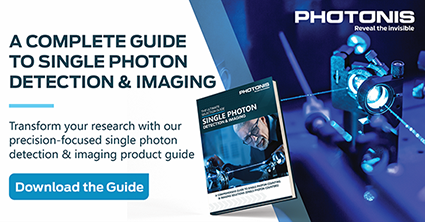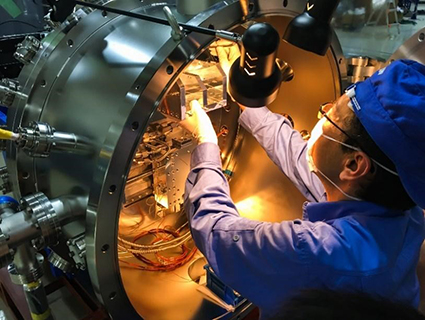Technical Challenges of Single Photon Detection - Overcoming Barriers to Detecting Photons
Contents:
Single Photon Detection Technologies Available Today
Challenges in Single Photon Detection
Challenges in Resolution and Dynamic Range
Market Size and Costs
New Emerging Applications
Frequently Asked Questions
Have you ever wondered how we can capture the faintest whispers of light from the depths of space or the most elusive particles in the quantum realm? The answer lies in the groundbreaking field of single photon detection. Detecting single photons, the tiniest building blocks of light, is crucial for various scientific and technological applications.
This technique is widely used in scientific research fields such as:
- High end LIDAR
- Quantum Optics and Quantum Telecommunication
- High Energy Physics
- Particle Physics
- Nuclear Physics
- Fluorescence Imaging
- Astronomy
- Plasma research and others.
Current single photon detection technologies face several challenges that must be overcome in order to achieve accurate and reliable single photon counting and imaging.

Single Photon Detection Technologies Available Today
Avalanche photodiodes (APDs)
APDs are semiconductor devices that operate in the reverse bias mode, and they can amplify the signal generated by a single photon to produce a measurable electrical current. APDs are typically used in applications where high detection efficiency and low noise are required. Drawbacks are their temperature sensitivity, limited linearity, and relative high cost.
Single photon avalanche diodes (SPADs)
SPADs are similar to APDs, but they are specifically designed to detect individual photons. When a photon enters the SPAD, it triggers an avalanche of electron-hole pairs, producing a measurable electrical signal. SPADs are used in quantum key distribution, quantum cryptography, and other applications where photon counting is critical.
SPADs are high-speed detectors with high sensitivity and low power consumption. They operate at room temperature and are commonly used in time-resolved fluorescence spectroscopy and fluorescence lifetime imaging applications. In comparison to other single photon detectors SPADS are suspicion to after pulsing, have a limited timing resolution, relatively long dead time and generate a high number of dark counts.
Transition-edge sensors (TESs)
TESs are superconducting detectors that operate at very low temperatures. They work by measuring the small changes in resistance that occur when a photon is absorbed. TESs are highly sensitive and can detect single photons with very high efficiency, making them ideal for use in astrophysics and other applications where extremely low light levels need to be detected.
TESs are ultra-sensitive detectors that operate at cryogenic temperatures. They have high detection efficiency, low noise, and high linearity, making them suitable for applications such as X-ray and gamma-ray spectroscopy. Due to their high cost, slow response time, temperature sensitivity, fragility and limited dynamic range, TESs are not widely adopted in other single photon applications.
-------------------------------------------------------------------------------------------------

-------------------------------------------------------------------------------------------------
Single Electron Transistor (SET) Detectors:
SET detectors are highly sensitive and can detect single electrons or photons. They have fast response times and are commonly used in quantum computing and quantum information processing applications. Their low efficiency, limited spectral range, and limited dynamic range makes them ill-suited for other single photon applications.
Superconducting nanowire single photon detectors (SNSPDs)
SNSPDs are also superconducting detectors that operate at very low temperatures. They work by measuring the small changes in resistance that occur when a photon is absorbed. SNSPDs are highly efficient and can detect single photons with high timing resolution, making them ideal for use in quantum optics and other applications where high-speed photon counting is required.
SNSPDs are ultrafast, highly sensitive, and have low dark count rates. They operate at cryogenic temperatures and are primarily used in quantum communication and quantum computing applications. The need to operate SNSPDs at cryogenic temperatures, limited dynamic range, limited spectral range and high cost are serious drawbacks.
Vacuum Tube-Based Photon Detectors
Vacuum-based photon detectors are devices that are designed to detect the presence of a single photon of light. These detectors are based on the photoelectric effect, which is the emission of electrons from a material when it is exposed to light. In a vacuum-based single photon detector, a thin layer of a material is illuminated with a photon which generates an electron which can be detected.
Vacuum-based photon detectors are highly sensitive detectors that can detect single photons with high efficiency. They have fast response times and are commonly used in applications such as: High end LIDAR, Quantum Optics and Quantum Telecommunication, High-Energy Physics, Particle Physics, Nuclear Physics, Fluorescence Imaging, Astronomy, Plasma research and others.
Challenges in Single Photon Detection
Detection Efficiency
One of the challenges of single photon counting is the low detection efficiency of single photons. Single photon detectors typically have a detection efficiency of only a few percent, which means that a large percentage of photons go undetected. This can result in a high rate of false negatives, which can make it difficult to accurately detect and measure weak light signals. Improving quantum efficiency is a key objective in the development of single photon detectors, as it directly impacts the overall performance of the device.
Signal Among the Noise
Another issue is the susceptibility of single photon detectors to noise. Single photon detection will be affected by dark counts, which are counts that are generated by the detector even when no photons are present. These spurious signals can severely limit the performance of single photon detectors, especially in low-light conditions.
Additionally, single photon detectors are affected by after pulsing, which is a phenomenon in which a detector generates a pulse after it has already detected a photon. Both types of noise can lead to false positives, which can make it difficult to accurately detect and measure weak light signals.
Challenges in Resolution and Dynamic Range
 For imaging applications, spatial resolution is of paramount importance. High spatial resolution allows for the distinction between closely spaced objects or features, enabling detailed images to be obtained.
For imaging applications, spatial resolution is of paramount importance. High spatial resolution allows for the distinction between closely spaced objects or features, enabling detailed images to be obtained.
Single photon counting pixelated cameras can detect and count individual photons, but the pixels are relatively large, which means that the spatial resolution of the image is low.
To achieve high spatial resolution, single photon detectors are often designed as pixelated arrays, such as those found in SPAD-based imaging systems. These arrays consist of multiple individual SPADs, each capable of detecting single photons independently.
Additionally, the dynamic range of single photon imaging is typically limited, which means that it can be difficult to capture images that have a wide range of brightness levels.
Market Size and Costs
Another limitation is the high cost of single photon counting and imaging systems. Single photon detectors and cameras are typically more expensive than traditional imaging systems, due to the high cost of the necessary components and the specialized nature of the technology. Associated volume is also limited which will not allow the manufacturers to have scale effect and to significantly decrease their production cost.
New Emerging Applications
Despite these challenges, single photon counting and imaging will revolutionize a wide range of scientific and technological fields. Besides use in forementioned fields like High-End LIDAR, Quantum Optics, High Energy Particle Physics and Plasma research, the use of single photon technology in Quantum key distribution applications is a practical example in which single photon counting can be used to detect and measure the faint signals emitted by individual quantum particles. Thereby making it possible to secure communications in a way that is fundamentally impossible to hack.
Photonis offers state of the art vacuum tube detector technology thereby delivering advanced solutions for the emerging single photon counting and imaging market, to REVEAL THE INVISIBLE!
-------------------------------------------------------------------------------------------------
To learn more about Photonis' current single photon counting and imaging technology, visit the product page:
-------------------------------------------------------------------------------------------------
Frequently Asked Questions (FAQs)
How do Vacuum Tube-Based Detectors Work?
Vacuum tube-based Image Intensifier tubes consist of several essential components; a Photocathode, a Microchannel Plate (MCP) and an anode. These components work together to amplify input signal, creating a rich and dynamic output.
In the first step, existing ambient light passes through a photocathode, which converts the incoming photon signal into a photo-electron.
In the second step, photoelectrons are drawn by an electrical field into the MCP where they impinge multiple times on the inner walls and thereby multiply several thousands of times. In photon counting applications the multiplied electron signal is detected using an anode. In the instance of photon imaging applications, the anode converts the electron back into photons to produce an image.
What are the Main Benefits of Vacuum Tube-Based Detectors?
Vacuum tube-based single photon detectors offer several benefits for single photon detection applications compared to other technologies.
Here are some of the main advantages:
- High sensitivity: Vacuum tube-based detectors are capable of detecting extremely low levels of light, down to the single photon level. This makes them well-suited for applications that require high sensitivity, such as quantum optics, fluorescence spectroscopy, and low-light imaging.
- Wide spectral range: Vacuum tube detectors have a wide spectral response range, spanning from ultraviolet (UV) to near-infrared (NIR) wavelengths. This versatility allows them to be used in a broad range of applications across different scientific disciplines.
- Fast response time: MCP-PMTs have fast response times, typically in the sub-nanosecond range. This enables them to accurately capture fast events or rapidly changing light signals, making them suitable for time-resolved measurements and applications requiring high temporal resolution.
- Large active area: MCP-PMTs have relatively large active areas compared to other single photon detectors. This makes them capable of detecting photons over a larger spatial area, which is advantageous for applications such as imaging and light detection in broad fields of view.
- Low noise: Vacuum tube-based detectors exhibit low noise characteristics, allowing for excellent signal-to-noise ratios. This is especially important for detecting weak light signals and enhancing the accuracy of measurements.
- High gain: MCP-PMTs provide high gain amplification due to their electron multiplication stages. Each photon that enters the detector can generate a cascade of electrons, resulting in a significantly amplified output signal. This high gain makes it easier to detect and measure single photons with improved signal quality.
- Versatility: Vacuum tube-based detectors can be used in a wide range of experimental setups and configurations, including single photon counting, photon correlation spectroscopy, fluorescence lifetime measurements, and many others. They are adaptable to different experimental requirements and can be integrated into various optical systems.
What are the Main Challenges in Single Photon Detection?
The main challenges in single photon detection include:
- Detection efficiency: The detection efficiency refers to the probability of a photon being detected by the detector. Achieving high detection efficiency is crucial in single photon detection applications. The efficiency depends on factors such as the detector technology, photon wavelength, and optical coupling efficiency. Maximizing detection efficiency is essential for capturing the highest possible number of photons.
- Timing resolution: Many applications involving single photon detection require precise timing information, such as in time-correlated single photon counting (TCSPC) or quantum cryptography. Achieving high timing resolution is challenging, as it requires fast electronics and detectors with short response times to accurately capture the arrival times of individual photons.
- Spatial resolution
- Spectral resolution
- Environmental and operating conditions
Integration and scalability: In some applications, there is a need for miniaturized or integrated single photon detectors. Challenges arise in developing compact, robust, and efficient detector designs that can be integrated into complex systems or small-scale devices while maintaining high performance.
What Impacts the Detection Efficiency of Single Photon Detectors?
Quantum Efficiency (QE) is a key objective in the development of single photon detectors, as it directly impacts the overall performance of the device.
What are the Limitations of Current Single Photon Detection Technologies?
Current single photon detection technologies often struggle to achieve high performance across all relevant metrics, such as sensitivity, timing resolution, spatial resolution, and spectral resolution, without compromising on other aspects of detector performance.
What are the Potential Applications of Single Photon Detection in the Future?
Single photon detection has potential applications in a wide range of fields, including quantum communication and computing, biomedical imaging, LIDAR, astronomy, and remote sensing.
How do Researchers Plan to Overcome these Technical Challenges?
Researchers are exploring novel materials, device architectures, and fabrication techniques to address the technical challenges in single photon detection. This includes the development of new materials, such as 2D materials or perovskites, improved detector designs, advanced signal processing algorithms, and innovative cooling and shielding techniques. By pushing the boundaries of what is possible in single photon detection, researchers aim to unlock the full potential of this groundbreaking technology for a wide range of scientific and industrial applications.





